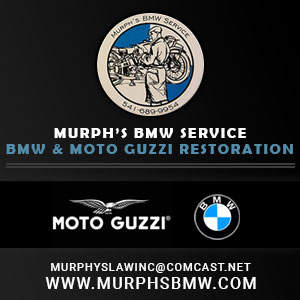'74 R90/6: left cylinder after or back firing above 3k rpm
My local machine shop has said the exhaust valves and guides are beyond spec so I'm sending them off to a BMW specialist for further work along with the rocker arms with the broken bearings. My local guys say the cylinders and pistons are fine but suggest a new set of rings as the end gaps measure .021. My problem is I want to sell the bike as soon as I get it running right but I'm not able to ride it myself to break in the rings, so I'm inclined to leave the original rings in it. Any thoughts? Maybe I should post this as a separate question.
Thanks
@10278 Re-using the original piston rings is permissible. But if you're going to go that way, then it's possible the valve work can also be by-passed. I would simply advise the seller that a nice LONG ride should be taken to seat things back in.
Obviously the rocker arm bearings and push rod tube seals are a must-do in order for the engine to operate correctly.
Owning an old Airhead is easy.
Keeping an old Airhead running great is the true test.
Thanks Richard for the reply
I'm still waiting for the return of the heads and I'm thinking about the re-assembly. I will be installing new push rod tube seals and I was wondering if there is a definitive position for the push rod tube in the cylinder. Videos I've seen appear to show the cylinder side edge of the tube "collar" to be about 2-3mm closer to the head than the plane of the mounting flange of the cylinder. The guy doing my heads says he sets that point about 1mm closer to the block than the plane of the flange, but he says it's not that particular.
Any thoughts? Thanks
so you removed the pushrod tubes from the cylinders? why? if you removed them did you record their position first?.
Sorry it took so long to reply. I've been keep out of the system for 2+ months.
It was quite common "back in the day" to drive the push rod tubes toward the engine block as a quick way to apply more pressure on the giant rubber push rod seal. This would stop the weeping that occurs when the seals start to harden (and thereby loose the ability to exert sealing pressure).
Bottom line, you DO need to check the position of the chrome PR tubes before installing the cylinder. And once installed, you do need to check the pressure applied to the new PRT-to-engine seals. I'm sure that there is a definitive measurement for the PRT's amount of extension, but I don't know that number. Snowbum's site may guide you.
All the best.
Owning an old Airhead is easy.
Keeping an old Airhead running great is the true test.
The original tubes are still in the cylinders but I had driven them further in over the years in an attempt to reseat the old seals. Now with new seals going in and the low compression base gasket coming out the tube position needs to be reset. The tubes are in good shape but should probably come out and be cleaned up as they will be going further into the cylinders. I have an engine shop doing this work and I will confirm with them the hot/cold method to accommodate the interference fit.
Any further thoughts?
Thank you, gentlemen
I have not consulted "Snowbum" yet. However, in most other engines... I'd be looking at the amount of compression the tube applies to the new seal.
Owning an old Airhead is easy.
Keeping an old Airhead running great is the true test.
I would press the tube extra deep into the cylinder then assemble and lastly drift the tube towards the seal to get compression. this assumes the collars are welded or brazed to the tubes and one has the correct factory tool.
I was at the shop yesterday and it turns out the tube collars are a millimeter or two closer to the block than the plane of the cylinder flange. My plan is to assemble things as they are and see how it works out. I doubt they will leak in this position and hopefully won't split. I'll let you know.
Thank you for your input
- 27 Forums
- 1,909 Topics
- 10.9 K Posts
- 4 Online
- 5,968 Members



